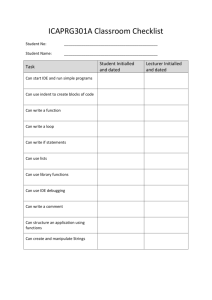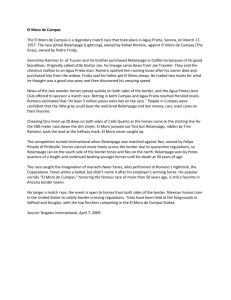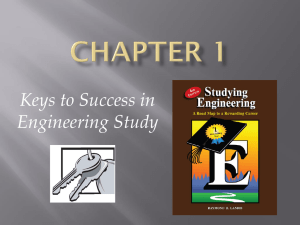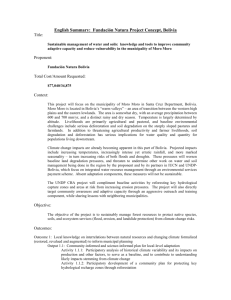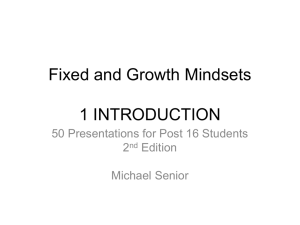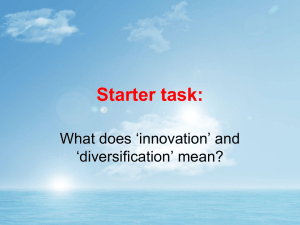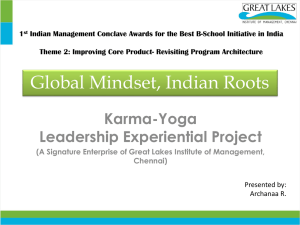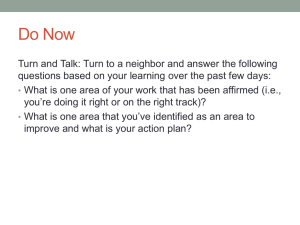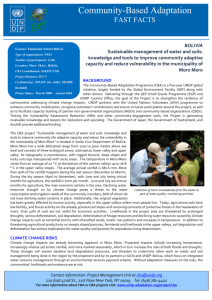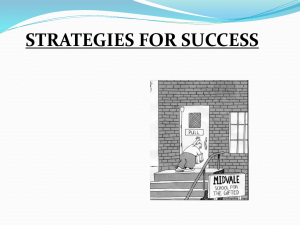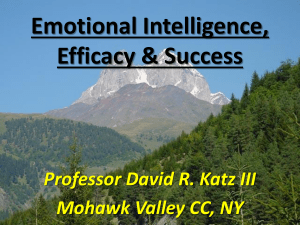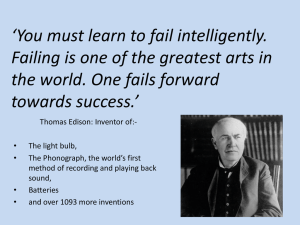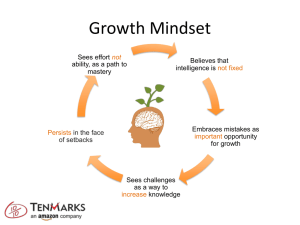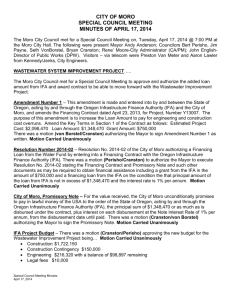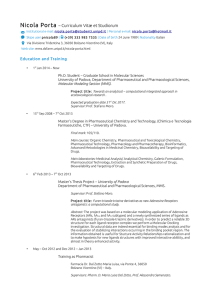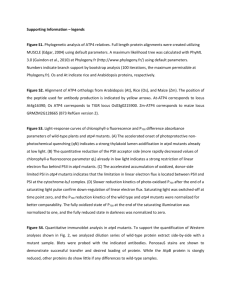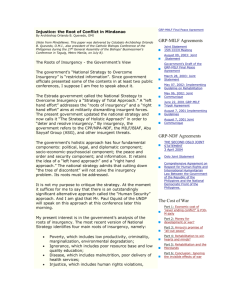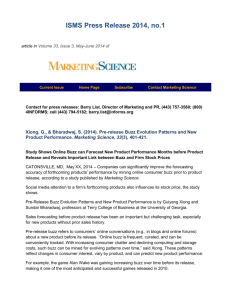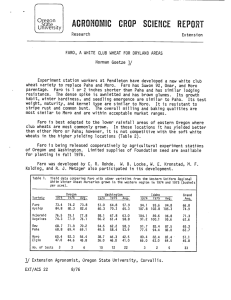Movement Programs
advertisement
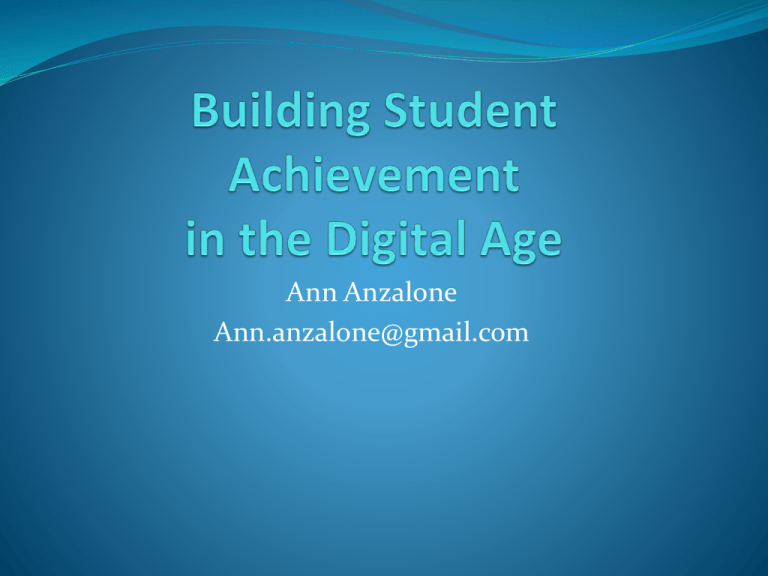
Ann Anzalone Ann.anzalone@gmail.com Reading Aloud Reading aloud and moderate to vigorous exercise are the greatest stimulators of brain circulation and metabolism.* Dr. Ryuuta Kawashima Train Your Brain Dr. Ryuuta Kasashima Literacy Good readers grow out of good reciters and good speakers. Using the Mind –Body Connection Integrated OneSided X ll Brain Integration Trotter integrated (dopamine) Pacer one sided Canter 3 legged Nothing Dr. Eugenius Ang, Yale Neurobiologist Cross Squat Breathing Technique improves memory, mental clarity and focus Cross Squat Breathing Technique Stand with feet shoulder distance apart, toes pointing forward. Hold both earlobes with arms crossed Over chest, right arm on top. Do a squat going as low as you can. Breathe in through your nose. Stand up, breathe out through your mouth. Repeat 12-20x. Writing Sample st 1 Grader th 8 Grader Communication 93% of all communication is nonverbal Develop Routines Clocks Play The right movements can stimulate and activate all brain subsystems while building and opening neural pathways, enhancing ability to take in, process, and express information GAMES As students interact with each other, they develop their relationships and trust levels with each other, enhance communication, improve cooperation, and achieve a sense of unity. Mirror Neurons Neuroscientist, Marco Iacoboni (UCLA) suggests that mirror neuron systems in the human brain help us understand the actions and intentions of other people and for learning new skills by imitation. GAMES teach how to Plan moves by examining many possibilities Think about consequences of action Pay attention Visualize future moves Plan ahead more than one step at a time Zoom Stand in a circle. One person starts the game by looking left or right and says, “Zoom!”. “Zoom” is repeated in the same direction until someone puts on the brakes by saying, “Eek!”. “Eek” reverses the direction. Brain Systems Prefrontal cortex Anterior cingulate gyrus Deep limbic system Basal ganglia Temporal lobes Cerebellum – balance Neurotransmitters Dopamine: learning, motivation, attention, movement Serotonin: helps keep brain activity under control, influences mood, impulsivity, anger and aggressiveness Norepinephrine: amplifies signals that influence attention, perception, motivation and arousal Glutamate: stirs up activity; is responsible for neurons firing together, wiring together GABA: clamps down on activity BDNF What makes us move is what makes us think. Aerobic Exercise 12 minutes a day Rebalances neurotransmitters and raises BDNF Jean Blaydes Making A Good Brain Great Dr. Daniel Amen The best sources of stimulation for the brain are: physical exercise mental exercise social bonding So Each May Learn Dr. Harvey Silver 4 A’s Attention Attention Reactive Focused Alphabet Moves A r B l C t D l E l F r G t H l I r J l Alphabet Moves K r L r M t N l O r P t Q t R l S r T l Alphabet Moves U t Z t V r W l X t Y l Reactive or Focused? 0 8 16 24 32 40 48 56 64 72 80 96 88 nd 2 A Attitude MindSet Dr. Carol Dweck 1. You can learn new things, but you can’t really change how intelligent you are. 2. No matter how much intelligence you have, you can change it quite a bit. MINDSET FIXED MINDSET GROWTH MINDSET rd 3 A Aspiration I am… 4th A Ask Foundation Skills Foundational skills like memorizing enable higher order thinking and deeper insight because they free students from having to use cognitive processing capacity in more basic calculations . The more proficient you are at lower-order skills, the more proficient your become at higher order skills. • Doug Lemov Teach Like a Champion Sensory Connections Vestibular Moro ATNR STNR Touch Moro Plantar Galant Auditory Moro ATNR Galant Visual Moro ATNR STNR Moro Reflex Startle Reflex Open arms and legs followed by closing in the fetal position. Deep pressure on the palms of the hands. Whole body hugging – arms and legs. Fear Paralysis withdrawal from touch, selective mutism, fear of separation from a loved one, clinging, aggressive or controlling behavior, craving constant attention and perfectionism. Spinal Galant Birthing Reflex Twisting - hula hoops; twister board Deep Pressure Foundation for coordinated movement. Falling asleep Calming down Focusing Sitting still The two hemispheres of the brain need to share information through electrical impulses. Learning Style Patterns Right whole to part Left part to whole end connections incubation pictures beginning details immediate words Learning Connection A Coordination B Perception C Auditory Processing Fizz Buzz Visual Processing 80% of Reading and Math Issues Fizz Buzz Count to 30 substituting the word Fizz for each multiple of 3. Buzz for each multiple of 5. Fizz Buzz for each multiple of 3 and 5 . Rapid Reading Read with the left index finger underlining the words increases the reading speed 25-50% Mind Power Knowledge Skill are the keys to the 21st century. 3 H’s Head Heart Hands BE SUAVE B E S U A V E Impact on Student Achievement Order of Highest to Lowest impact Mastery learning Homework Teacher clarity Feedback/ F/S assessment Aims & policies of the school Peer tutoring Teacher-student relationships Expectations by students Best Predictor of Student Success Reading scores Motivation level Math scores Attitude Working memory Working Memory Reflects your ability to hold information in memory while doing something else at the same time. Choke What the Secrets of the Brain Reveal about Getting It Right When You Have To Sian Beilock Brain Speed Exercise is the antidote to brain stress. Play games like Jeopardy, Concentration, Memory, Boggle Work puzzles, crossword puzzles, word searches, Sudoku. Do mental math. Memorize poems. Make ABC lists. Read. Practice Speed Stacking Exercise •Think Fast!!! High Return Achievement Factors S________________ E______________________ Hope and Growth Mindset F____________________ Relationships T__________________ S____________ What is the greatest motivator in the workplace? Recognition for good work Incentives for work well done Management support Interpersonal support Clear achievable goals Making progress Movement Programs Infinity Walk Dr. Deborah Sunbeck Brain Gym Gail and Paul Dennison S’Cool Moves Deb Wilson Minds In Motion Candance Meyer Information in the Digital Age Tacit Knowledge Can’t be written down Ability to speak a language Requires extensive personal Explicit Knowledge can be written down Identify vocabulary words and symbols contact, regular interaction Based on beliefs, ideals, values, Mental models Observation, imitation Know how know why, what , who Play Station Nation There was a child went forth every day, And the first object he look’d upon, that object he became, And that object became part of him for the day or a certain part of the day, Or for many years or stretching cycles of years. Walt Whitman Apprenticeships What today’s students lack is practical experience. Experience shapes the brain. Development plays a role. ePortfolio Earthing The images here were taken only thirty minutes apart - before (left) and after grounding (right). They illustrate a rapid resolution of inflammation and help explain the impact of Earthing on chronic pain, stiffness, and a variety of symptoms. Dr. Stephen Sinatra Earthing When you are grounded, there is a transfer of free electrons from the Earth into your body. They are probably the most potent antioxidants known to man. Beneficial changes in heart rate Decreases levels of inflammation • • Dr. James Oschman Go Barefoot LEARNING 80% INPUT Physically building memories 1. Read, listen, watch 2. Think: ask, answer, discuss 3. Write: cognitive map to consolidate memories Note Making the ability to collect, organize and manage information from the text Re-work notes and text into one “whole”. #1 Skill for Learning Note Making Spend more time actively reciting and less time just re-reading. Reciting is one of the most powerful ways to learn and remember. Constantly practice restating, repeating, putting into your own words what you’ve just learned forcing the left and right brain to work together. What Color Is Your Brain? Sheila N. Glazov Yellow have to Blue love to Green need to Orange want to Point of View We don’t see things as they are. We see them as we are. Modalities VISUAL See EYE MOVEMENTS AUDITORY KINESTHETIC Hear/Say up, right level, right up, left level, left straight down, left closed Straight down Do down, right Eyes Visual Auditory Kinesthetic Blur 6 Steps 1. Name the type of content. 2. Is the content complete? Who or what are the sources? 4. What evidence is presented? 5. What might be another explanation? 6. Am I learning what I need to learn? 3. Nutritionally Speaking Diet provides the fuel for the brain to work. Eat breakfast! Eating protein in the first ½ hr of getting up evens out the blood sugar for the whole day. The Crazy Makers 1821 sugar consumption averaged 10 lbs. per person per year 1993 averaged 147 lbs. sugar and 50 lbs of noncaloric sweetener 2003 174 lbs. per person per year The influence of a high sugar diet on brain chemistry: hyperactivity, depression, inability to focus and concentrate 8 HOURS Healthy SLEEP Dropping below • • • • - 2x the rate of Clinical depression Moodiness Impulsiveness Disengagement Sleep Cycles 4 90 minute cycles superficial to deep At least 7 hours a night Delta Deep Dark Sleep Trouble falling asleep, tossing and turning, waking and falling back asleep, getting up two, three or four times a night to urinate, being startled awake by some minor noise and other sleep problems could be indicative of a nutritional deficiency that allows susceptibility to the things that commonly wake you up or keep you awake at night. Often it is a mineral deficiency. Salt is vital for sleep regulation. It is a natural hypnotic.

